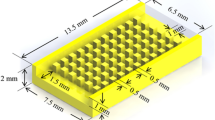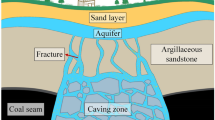Abstract
The hydrodynamic efficiencies of perforated plates arranged at different inclinations are assessed through experimental investigations. Wave absorption capability of the perforated plates is governed by the optimum porosity and the slope of the structure. The reflection and transmission characteristics of waves influenced by the perforated plate exposed to different incident wave conditions are analysed for different porosities and slopes. The modified predictive equation for estimating wave reflection for impermeable plate is derived through experiments. Better wave absorption is observed for a plate with 10 % porosity and 15° slope. The details of the effects of slope and porosity of the inclined perforated plate on the wave reflection and transmission are discussed in this paper.













Similar content being viewed by others
References
Moraes CDC (1970) Experiments of wave reflexion on impermeable slopes. In: Proceedings of 12th Conference on Coastal Engineering, Washington, D.C, pp 509–21
Battjes JA (1974) Surf similarity. In: Proceedings of the 14th International Conference on Coastal Engineering, New York, pp 466–80
Sunamura T, Okazaki S (1991) Re-examination of breaker-type classification on uniformly inclined laboratory beaches. J Coastal Res 7(2):559–564
Seelig WN, Ahrens JP (1981) Estimation of wave reflection and energy dissipation coefficients for beaches, revetments, and breakwaters. No. CERC-TP-81-1. MS, Fort Belvoir
Sunamura T, Okazaki S (1996) Breaker types and wave reflection coefficient: laboratory relationships. J Coastal Res 12(1):240–245
Allsop NWH, Hettiarachchi SSL (1989) Wave reflections in harbours; the design, construction and performance of wave absorbing structures. Report OD 89. Hydraulics Research, Wallingford
Zanuttigh B, Van der Meer JW (2008) Wave reflection from coastal structures in design conditions. Coast Eng 55(10):771–779
Neelamani S, Sandhya N (2003) Wave reflection characteristics of plane, dentated and serrated seawalls. Ocean Eng 30(12):1507–1533
Neelamani S, Sandhya N (2005) Surface roughness effect of vertical and sloped seawalls in incident random wave fields. Ocean Eng 32(3):395–416
Cho IH, Kim MH (2008) Wave absorbing system using inclined perforated plates. J Fluid Mech 608:1–20
Acanal L, Loukogeorgaki E, Yagci O, Kirca VO, Akgül A (2013) Performance of an inclined thin plate in wave attenuation. J Coast Res 65:141–146
Evans DV (1990) The use of porous screens as wave dampers in narrow wave tanks. J Eng Math 24(3):203–212
Twu SW, Lin DT (1991) On a highly effective wave absorber. Coast Eng 15:389–405
Neelamani S, Al-Salem K, Taqi A (2017) Experimental Investigation on wave reflection characteristics of slotted vertical barriers with an impermeable back wall in random wave fields. J Waterw Port Coast Ocean Eng 143(4):06017002
Alsaydalani MO, Saif MA, Helal MM (2017) Hydrodynamic characteristics of three rows of vertical slotted wall breakwaters. J Mar Sci Appl 16(3):261–275
Mansard EPD, Funke ER (1980) The measurement of incident and reflected spectra using a least squares method. In: Proceedings of 17th Conference on Coastal Engineering, Sydney, Australia, 154–72. http://journals.tdl.org/icce/index.php/icce/article/view/3432/3112
Gupta K, Balaji R (2017) Wave shoaling over steep slopes-an experimental investigation. Ocean Eng 143(March 2016): 79–87. https://doi.org/10.1016/j.oceaneng.2017.07.051
Author information
Authors and Affiliations
Corresponding author
Additional information
Publisher’s Note
Springer Nature remains neutral with regard to jurisdictional claims in published maps and institutional affiliations.
Rights and permissions
About this article
Cite this article
Krishnendu, P., Ramakrishnan, B. An Experimental Study on Interaction of Regular Waves with Steep Inclined Perforated Plates. Exp Tech 46, 17–26 (2022). https://doi.org/10.1007/s40799-021-00463-3
Received:
Accepted:
Published:
Issue Date:
DOI: https://doi.org/10.1007/s40799-021-00463-3




